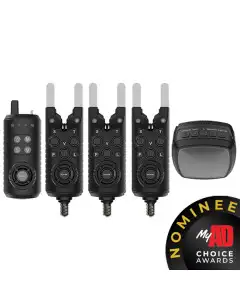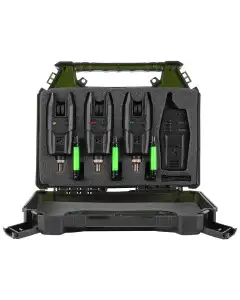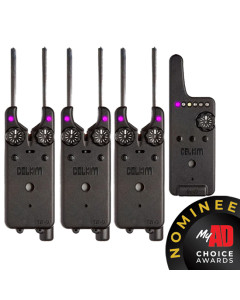This is a demo store. No orders will be fulfilled.
Choosing and Using Fishing Bite Alarms Effectively

Fishing isn't just a hobby; it's a lifestyle, a connection to nature, and a pursuit of the thrill of the catch. In this pursuit, bite alarms are your trusty companions, the silent sentinels that transform your fishing game. In this guide, we will explore bite alarms and how they can improve your fishing skills.
So, whether you're a seasoned angler looking to fine-tune, or a beginner on your first fishing journey, you're in the right place. Join us as we uncover the secrets of bite alarms.
Modern technology in fishing bite indicators can detect even the smallest bites or strong strikes. This leads to more successful fishing trips. Let's dive in and discover the key to enhancing your angling experience!
Understanding Bite Alarms
What Are Bite Alarms?
Bite alarms are the unsung heroes of the angler's arsenal. At their core, bite alarms are sophisticated electronic devices designed to alert you when a fish has taken the bait, even when you're not watching your fishing rod like a hawk.
These nifty gadgets boast a range of basic functions, primarily centred around detection and notification. When a fish nibbles, bites, or even engulfs your bait, the bite alarm springs into action. It senses the movement or tension on your fishing line and translates it into a signal, usually a sound or visual indicator, alerting the angler of the fish's presence.
How Does A Bite Alarm Work?
In fishing, bite alarms act as your vigilant sentinels, tirelessly monitoring your lines and vigilantly guarding your precious hooks. They use sensors, often in the form of vibration detectors or line tension sensors, to detect any unusual movements or disturbances on your fishing line.
When a fish interacts with your bait, whether it's a tentative nibble or a full-fledged strike, these sensors spring into action. The bite alarm swiftly processes the signal and sends you an unmistakable alert – a beep, a flashing light, or a combination of both – informing you that it's time to strike and set the hook.
Why Use Bite Alarms?
In the world of angling, bite alarm setups are an innovative tool for those who seek to elevate their fishing game. Let's delve into the compelling reasons why you should embrace these technological wonders.
1. Immediate Detection: Bite alarms are your dedicated fishing partners, the silent observers that ensure you never miss a fish's invitation to play. Whether it's a subtle nibble or a powerful strike, bite alarms don't miss a beat. They ensure you're alerted the moment a fish shows interest in your bait, minimising the risk of missed opportunities.
2. Efficiency Multiplied: By allowing you to focus on multiple rods simultaneously or engage in other aspects of your fishing experience, such as preparing bait or relaxing by the water, they make fishing not only more efficient but also more enjoyable.
3. 24/7 Fishing: With bite indicators for fishing, your angling adventures aren't limited to daylight hours. Fishing becomes a round-the-clock pursuit. These devices are your trusted companions for night fishing, ensuring you're always ready to respond to a bite, even under the cover of darkness.
4. Reduced False Alarms: Bite alarms are finely tuned to detect genuine fish activity while minimising false alarms caused by wind, water currents, or other environmental factors. This precision ensures that you're only alerted when it truly matters.
5. Enhanced Relaxation: Fishing should be a leisurely and enjoyable experience, and bite alarms contribute to that by allowing you to relax and unwind by the water. You can focus on other aspects of your angling adventure, such as enjoying nature, socialising with fellow anglers, or savouring a peaceful moment.
6. Heightened Anticipation: Every alert from your bite alarm sends a rush of adrenaline through your veins. The anticipation of what's on the other end of your line adds an element of excitement to your fishing, turning each catch into a thrilling adventure.
7. Reduced Stress: Bid farewell to the stress of constantly watching your rods for signs of fish activity. Bite alarms liberate you from this tireless vigil, allowing you to relax more and savour the tranquil moments by the water.
8. Learning Opportunity: By using bite alarms, you gain valuable insights into fish behaviour. You can start to recognise patterns in when and how fish are biting, ultimately becoming a more knowledgeable and successful angler.
9. Weather Resilience: Bite alarms are generally resilient to various weather conditions, ensuring consistent performance. This reliability ensures that the anglers have a persistent ally in different weather conditions, supporting them in maximising their catch.
10. Effective in Challenging Environments: Bite alarms prove to be particularly effective in challenging fishing environments such as windy conditions or fast-flowing waters, ensuring that the angler doesn’t miss any potential catches in such scenarios.


How to Set Up a Bite Alarm
Before setting up your bite alarm, make sure you've taken care of the following preparations:
- Get a Suitable Pod: Ensure you have a compatible rod pod or holder to attach your bite alarm.
- Check Batteries: Make sure your bite alarm has fresh batteries to operate effectively.
- Prepare Bobbins: Have bobbins ready for use as the alarm thread. Ensure they are compatible with your setup for optimal results.
Now, let's go through how to set up your carp bite alarms:
1. Secure your buzzbars: Ensure the thread of your buzzbars is screwed into your rod pod.
2. Position the Alarm: Set up the alarm so it faces away from the water, and if needed, use additional bolts to secure it firmly in place.
3. Thread the Fishing Line: Run your fishing line through the alarm, and avoid putting excessive pressure on the line to prevent damage.
4. Attach the Bobbin: Securely attach the bobbin to serve as the thread for your alarm. Your bobbin should be able to move freely along the line.
5. Power On the Bite Alarm: Ensure your bite alarm is powered on and has sufficient battery life. Adjust the volume and sensitivity settings on the bite alarm as needed for your fishing conditions.
6. Receiver Connection (Optional): If you have a receiver for your bite alarms, make sure it's paired and connected to the alarms. This allows you to monitor multiple rods from a distance.
7. Test the Setup: To make sure everything is working correctly, give your fishing line a gentle tug to see if the bobbin moves and triggers the bite alarm. Adjust the sensitivity settings if necessary.
Key Features to Consider


Light Indicators - Many carp alarms come with various LED colour options to cater to your personal preferences. These colour options were designed to help you distinguish between your rods during low-light situations.
Volume & Tone Control - Many of our bite alarms offer customisable tones for each alarm, allowing you to quickly identify your active rod. You can also adjust the volume to avoid disturbing nearby anglers. Some alarms provide a mute option, which is particularly useful when used alongside a receiver setup.
Sensitivity - Reducing the chances of false alarms on windy days or in areas with strong currents. Alarms equipped with wheels and magnets grant you precise control over sensitivity by altering the frequency at which the magnet passes over the sensor.
Batteries - Most of our alarms feature low-power notifications, prompting you to replace the AAA batteries or recharge with a compatible rechargeable battery. When selecting an alarm, consider the ease of accessing the battery compartment, as seamless battery replacement is essential for uninterrupted fishing.


Waterproofing - Many carp alarms come with waterproofing, ensuring they can withstand even the heaviest rain without compromise. These alarms typically feature a robust plastic shell or a waterproof rubberised coating, making them suitable for use in all weather conditions.
Multi-Rod Monitoring - For those who fancy managing multiple rods, some bite alarms come equipped with features that enable the monitoring of multiple lines. This amplifies your presence across several points, increasing your chances of a successful catch.
Range - Range is a factor that brings an additional dimension to your equipment. A longer range offers flexibility and freedom, allowing you to roam without losing contact with your rod. So, choose a bite alarm with a range that aligns with your fishing style and location preferences.
Connectivity - In the modern arena of angling, where technology is our steadfast ally, consider bite alarms that offer connectivity features. Most bite alarm presentation sets come with a receiver that can connect to all your alarms and display when each one has an indication, remotely.
Improving Your Fishing with Bite Alarms
Using bite alarms doesn't just enhance your catch rate; it transforms your entire fishing experience. However, there are ways to tailor your alarms further to get the most out of your fishing experience.
1. Proper Setup
Ensure that your bite alarm is correctly set up. Place it at an optimal distance from the rod tip to maximise sensitivity and accuracy. Read the manufacturer's instructions carefully and set up the device as recommended for best results.
2. Lowering the Volume
In tranquil settings, having a blaring bite alarm can be more disruptive than helpful. Lowering the volume is a subtle but significant adjustment that can make all the difference. By reducing the noise level to a hushed tone, you minimise disturbances and increase your chances of a successful catch.
3. Personalising with LED Lighting
Why not add a touch of personalisation to your fishing setup? Many modern bite alarms come equipped with LED lighting options. Customise each alarm with a different colour or pattern to distinguish between them easily.
This not only adds a visual element to your fishing experience but also helps you quickly identify which rod is signalling a bite. It's like giving your gear a unique personality.
4. Do you need a bobbin with a bite alarm?
Bobbins are another valuable tool in your arsenal. They not only act as visual indicators but also provide a secondary level of sensitivity adjustment.
By using bobbins, you can fine-tune your bite alarms to match your fishing conditions. Whether you prefer light or heavy bobbins, their responsiveness can be a game-changer in detecting the subtlest of bites or the most aggressive strikes.
5. Changing the Tone
Just like music, the tone of your bite alarms can set the mood for your fishing session. Many bite alarms allow you to select from a variety of tones or even upload custom ones. Experiment with different tones to find what works best for you and your fishing style. A unique tone for each alarm can help you instantly recognise which rod requires your attention, making your angling experience even more immersive.
6. Sensitivity Settings
Fine-tuning the sensitivity of your bite alarms is crucial. Adjust these settings based on the conditions you're fishing in. On windy days or when fishing at long distances, lower sensitivity can help reduce false alarms. Conversely, in calm conditions or when fishing close to your rod, higher sensitivity will ensure you don't miss even the slightest nibble.
7. Night Fishing Considerations
For anglers who enjoy night fishing, it's essential to choose bite alarms with features designed for low-light conditions. Opt for alarms with illuminated indicators or backlit displays, making it easier to detect and respond to bites during the dark hours.
8. What are snag ears on a bite alarm?
Snag ears or bars are retractable ears that play a crucial role in securely holding your rod in place during side takes, preventing accidental loss into the water. Some bite alarms come with line clips or line guards to secure your fishing line. Using these can help prevent tangles and ensure your line stays in place, improving your hookup rate when you get a bite.
9. Practice and Patience
No matter how well you tailor your bite alarms, success in carp and specimen fishing also depends on practice and patience. Learn to recognise the different signals your alarms provide, and don't be quick to strike.
10. Pair with Suitable Rods and Lines
Ensure that your bite alarms are compatible with the rods and lines you are using. The right pairing will enhance the efficiency and responsiveness of the alarms.
11. Use in Suitable Scenarios
While bite alarms are beneficial, they are not necessary for all fishing scenarios. Use them where they add value, such as in night fishing or when managing multiple rods, to truly capitalise on their benefits.
12. Environmental Adaptation
Adapt the usage of your bite alarms according to different environmental conditions. Understanding how your bite alarms perform in various weather conditions and water types will allow you to use them more effectively.
- Compatibility Check: Ensure that your receiver is compatible with your specific bite alarm model. Check the user manual for compatibility information.
- Power On: Ensure both the receiver and bite alarm are powered on and have sufficient battery life.
- Sync Devices: Pair the receiver with the bite alarm by putting the receiver and bite alarm in pairing mode (refer to the receiver's manual). The devices will search for each other and establish a connection.
- Verify Connection: After pairing, check the receiver's display or indicators for confirmation. Some receivers emit sounds or display symbols to indicate a successful connection.
By tailoring your bite alarms to your preferences and fishing conditions, you not only increase your chances of success but also enhance the overall experience.
Maintenance and Care of Your Bite Alarms for Fishing
Cleaning and Storage
Properly storing your bite alarms is essential for ensuring the longevity and reliability of your equipment. As you pack away your bite alarms at the end of the session, wipe them down with your trusted fishing towel.
Store them in a cool, dry place, preferably in a protective case or pouch, to shield them from dust and moisture. Regular maintenance not only extends the lifespan of your bite alarms but also guarantees they remain in peak working condition when you're ready for your next angling adventure.
How do you clean a bite alarm?
Battery Replacement
Regularly inspect your bite alarms for low battery levels before each outing, and consider replacing the batteries annually to ensure consistent performance. Always carry spare batteries with you to avoid surprises in the field. Use high-quality batteries recommended by the manufacturer and replace all of them at once if your alarms require multiple batteries.
Opt for bite alarms with easily accessible battery compartments, and when not in use, remove the batteries to prevent corrosion. These practices will help you maximise the reliability of your bite alarms and ensure a successful fishing experience.
Weatherproofing of Bite Alarms
Carp anglers will often expose their gear to the elements. Ensure your carp fishing bite alarms are weatherproof or protected by covers to prevent damage from rain or dew. A rain cover can keep your alarms functioning optimally in wet conditions.
What are the best bite alarms?
When it comes to choosing the best bite alarms for your fishing needs, several top brands and models are worth considering. Here are some of the popular options:
1. Delkim Bite Alarms: Delkim is renowned for its high-quality and reliable bite alarms. The Delkim TXi Plus and the Delkim EV-D Digital are popular choices among anglers due to their sensitivity and customisable features.
2. Fox Bite Alarms: Fox offers a range of bite alarms known for their durability and precision. The Fox Micron MX+ and Fox RX+ Digital are favoured by many anglers for their accuracy and versatility.
3. Sonik Gizmo Bite Alarm: Sonik Gizmo Bite Alarms are known for their affordability without compromising on performance. They offer reliable bite detection and are great for anglers on a budget.
4. Nash Bite Alarms: Nash offers bite alarms like the Nash Siren S5 and Nash Siren R3 which are known for their sensitivity and advanced features. These alarms provide excellent value for their performance.
5. Prologic Bite Alarms: Prologic's bite alarms, such as the Prologic SNZ Bite Alarm, are known for their user-friendly design and affordability. They provide reliable bite indications for anglers of all levels.
The best bite alarms for you will depend on your specific fishing style, preferences, and budget. Consider factors like sensitivity, volume control, LED indicators, and durability when making your decision.
It's also a good idea to read reviews and seek recommendations from fellow anglers to find the perfect bite alarms that suit your needs. Ultimately, the "best" bite alarms are those that help you catch fish effectively while providing the features and reliability you desire.
In essence, bite alarms are not just fishing accessories; they're game-changers that elevate your angling experience to new heights. They grant you the freedom to fish more efficiently, enjoy your time by the water to the fullest, and connect with the essence of the sport in ways that are both thrilling and deeply satisfying.
Bite alarms are the secret to turning every fishing trip into a richer, more successful, and unforgettable adventure. By choosing the right bite alarms and using them skillfully, you can significantly enhance your catch rates and elevate your overall fishing experience.
So, as you head out to the water, remember that careful consideration of your bite alarms can make all the difference. Invest in quality equipment, master their use, and watch as your fishing adventures become more successful and rewarding than ever before.
FAQ’s on Bite Alarms for Fishing
Do you need a receiver for bite alarms?
A receiver is not essential for bite alarms as they have adjustable volume. However, using a receiver is advisable, especially at night or in quiet fishing locations, to avoid disturbing other anglers. It allows for a quieter alarm head while the receiver kept closer to the angler, indicates a bite.
How do I connect my bite alarm to my receiver?
To connect a bite alarm to a receiver, initiate the pairing mode on both devices. Consult the user manuals for specific pairing instructions, usually involving pressing certain buttons or performing a sequence of actions, ensuring a secure connection between the two devices.
What is the best battery for a bite alarm?
The best batteries for a bite alarm are lithium batteries. They are renowned for their longevity and consistent performance, even in varying temperatures, making them ideal for fishing activities. Additionally, they are lightweight, suiting anglers who wish to minimise equipment weight.
How do you check if your bite alarms are off?
- Visual Inspection: Many bite alarms have LED indicators or displays that will be active when they are turned on and will turn off when they are off.
- Sound Test: Gently tap the line or cause some movement to trigger the alarm. If you don't hear any sound, the alarm may be off.
- Battery Check: If the batteries are dead or missing, the alarms won't work.
- Function Buttons: Some bite alarms have power buttons or switches that can be used to turn them on and off.
- Remote Control: If your bite alarms are controlled by a receiver, test the remote by pressing the corresponding buttons to see if the alarms respond.
- Sensitivity Adjustment: If the sensitivity is set too low, the alarms may not trigger even when there is a bite.
If you've tried all these steps and still can't determine whether your bite alarms are off or malfunctioning, consult the user manual or contact the manufacturer's customer support.
Are korum bite alarms waterproof?
Many Korum bite alarms are designed to be water-guarded against the splashes and moisture encountered during fishing. However, for complete waterproofing and added protection, it's advisable to consider using case covers or additional waterproofing measures to ensure the longevity and functionality of your bite alarms in wet conditions.













